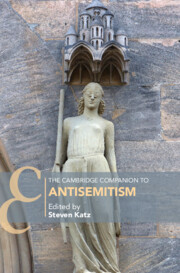Book contents
- The Cambridge Companion to Antisemitism
- Cambridge Companions to Religion
- The Cambridge Companion to Antisemitism
- Copyright page
- Contents
- Contributors
- Acknowledgments
- Introduction
- Part I The Classical Period
- Part II Medieval Times
- 8 The Medieval Islamic World and the Jews
- 9 Medieval Western Christendom
- 10 Christian Theology and Papal Policy in the Middle Ages
- 11 Crusades, Blood Libels, and Popular Violence
- 12 Jews and Money
- 13 Jews and Anti-Judaism in Christian Religious Literature
- 14 Antisemitism in Medieval Art
- Part III The Modern Era
- Appendix The International Holocaust Remembrance Alliance: Working Definition of Antisemitism
- Index
- Cambridge Companions to Religion
- References
14 - Antisemitism in Medieval Art
from Part II - Medieval Times
Published online by Cambridge University Press: 05 May 2022
- The Cambridge Companion to Antisemitism
- Cambridge Companions to Religion
- The Cambridge Companion to Antisemitism
- Copyright page
- Contents
- Contributors
- Acknowledgments
- Introduction
- Part I The Classical Period
- Part II Medieval Times
- 8 The Medieval Islamic World and the Jews
- 9 Medieval Western Christendom
- 10 Christian Theology and Papal Policy in the Middle Ages
- 11 Crusades, Blood Libels, and Popular Violence
- 12 Jews and Money
- 13 Jews and Anti-Judaism in Christian Religious Literature
- 14 Antisemitism in Medieval Art
- Part III The Modern Era
- Appendix The International Holocaust Remembrance Alliance: Working Definition of Antisemitism
- Index
- Cambridge Companions to Religion
- References
Summary
Antisemitism in medieval art is explored through selected images that develop the popular pictorial themes of “Christ-killing,” spiritual blindness, demonic allegiance, conspiracy, and animality. The imagery is linked to long-standing Christian theological beliefs and considers the social functions and material consequences for medieval Jews.
Keywords
- Type
- Chapter
- Information
- The Cambridge Companion to Antisemitism , pp. 248 - 270Publisher: Cambridge University PressPrint publication year: 2022



